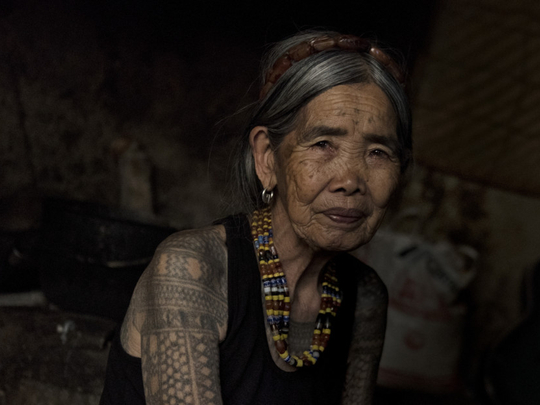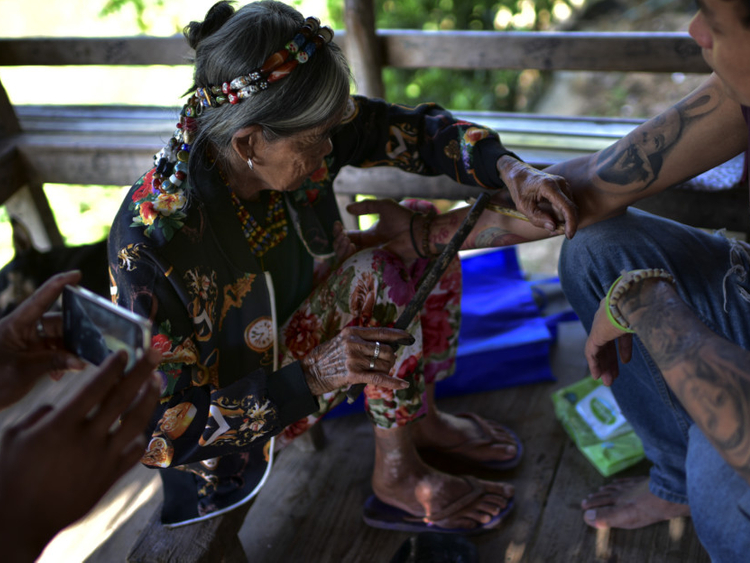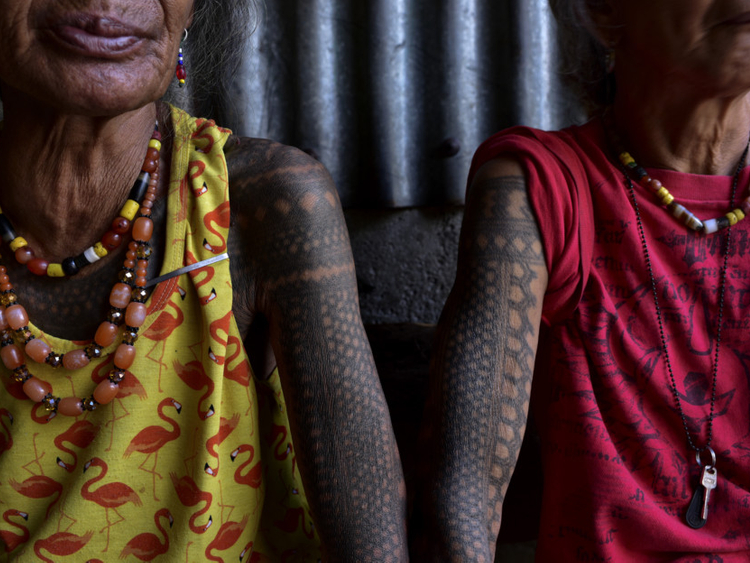
She wakes up every morning at dawn and mixes an ink out of pine soot and water. She threads a thorn from a bitter citrus tree into a reed, crouches on a 3-inch-high stool and, folded up like a cricket, hand-taps tattoos onto the backs, wrists and chests of people who come to see her from as far away as Mexico and Slovenia.
The woman, Maria Whang Od Oggay, will finish 14 tattoos before lunch — not a bad day’s work for someone said to be 100 years old. Moreover, she has single-handedly kept an ancient tradition alive, and in the process transformed Buscalan, a remote mountaintop village into a haven for tourists seeking adventure and a piece of history under their skin.
Buscalan, population 742, is a mile hike from the nearest dirt road through foggy forest and centuries-old rice terraces. The stilted huts are made of wood and thatch or galvanised tin and concrete blocks. There is no mobile phone service and little electricity. Black boars and chickens roam the narrow paths of stone and dirt.
Fang-od, also spelled Whang-od, is a ritual tattoo artist of the Butbut tribe of the Kalinga ethnic group in the northern Philippines.
When the Spanish first arrived in 1521, tattooing was widespread across the islands that would eventually make up the Philippines. Over the centuries, discouraged by colonial powers and Catholic teachings, the tradition faded.
The Kalinga, in the inaccessible mountains known as the Cordillera Central, fiercely guarded their villages against outsiders and held on to their customs. But by the middle of the 20th century, even their tattooing practices were slipping into history.
Fang-od belongs to the last generation bearing a full set of traditional tattoos and is one of the few who remember how they were done. She was set to die in obscurity until an American anthropologist, Lars Krutak, included her in his 2009 documentary series, “Tattoo Hunter”. Today, she is at the centre of a rush of visitors hoping to get a tattoo from a woman who herself seems like an artefact from another time.
Before the documentary, if Buscalan was known for anything, it was for growing marijuana. The occasional hikers passing through to buy hash oil have since turned into a wave of tattoo tourists. Tourism in Kalinga province, where Buscalan is the most popular destination, has increased more than five-fold, from about 30,000 in 2010 to almost 170,000 in 2016.
Most come to see Whang Od. They take a number and hope to be tattooed by her, while others settle for a tattoo from one of her grandnieces, who have begun to carry on the tradition.
“I was surprised,” Whang Od said of the many people who have come to see her.
She says she is still waiting for a visit from her celebrity crush, the Filipino actor Coco Martin. For now, she contents herself with a life-size cardboard cutout.
Fang-od is thin and hunched, but strong from a life of farming Buscalan’s terraced slopes. She is toothless but wears bright dentures, and is quick to laugh and tell jokes. Her thick grey hair is twisted around a headband of ocher stone beads, and her wrists are stacked with bracelets.
Along her collarbone, and from her shoulder blades to the backs of her hands, she is tattooed in faded geometric patterns of snakeskin, python and caterpillars, Kalinga symbols of protection, strength and guidance. Small tattoos are settled into the creases of her chin and forehead. She never married, but barely legible on her wrists are the names of some of her boyfriends — Bananao, Basongit, Francis.
She loved them all the same, she said. Fang-od was born before the tribe kept birth records, but her family estimates she turned 100 in February.
A century ago, tattoos for Kalinga women were decorative. They represented beauty and status. Kalinga men earned tattoos through acts of bravery, notably through ritual headhunting.
A boy could earn his first tattoo by walking up behind an unsuspecting fellow villager and spearing him in the buttocks, inflicting a flesh wound, before working his way up to joining headhunting expeditions.
Hand-to-hand combat with a spear, a shield and an axe specifically for chopping off heads earned the bravest chest tattoos. Warriors who killed more than 10 men earned symmetrical tattoos that covered the torso and arched into the upper arms.
In the 1930s, the national government, then administered by the United States, began suppressing trophy tattoos, and women started to cover their upper bodies. Headhunting went from being an act of valour to a crime.
Students were told to attend school in long sleeves to cover their tattoos. Missionaries and teachers told the Kalinga that their markings were barbaric, would keep them from getting jobs and identified them as criminals. But changing values are again changing Buscalan.
On a recent Sunday, Conradine King-Gonzalo, 27, a businesswoman, travelled 13 hours by bus from Manila to get a tattoo from Whang Od. “She’s a legend,” King-Gonzalo said. This was her second trip. The first time, Fang-od was away, so she went to one of her grandnieces. “I won’t stop until I get a tattoo from Apo,” she said, referring to Fang-od using the Kalinga word for grandmother.
Paulo Vega, 29, an Australian tattoo artist from Prague, saw his trip as a pilgrimage. He came to photograph his electric tattoo gun alongside Fang-od’s simple tools. “It’s so much more special getting a tattoo from her versus walking into a parlour and getting one from me,” he said, as he watched Fang-od tattoo a tourist with rapid, precise taps. “There’s a lot more soul to it.”
Buscalan has new guesthouses, a restaurant and small shops selling canned goods and souvenirs. Men work as guides and porters, communicating on walkie-talkies.
Tourism has enriched the village, allowing it to pave some paths and trade thatch roofs for tin. Whang Od’s relatives, who used to have no water buffaloes, now own 50. Even the blacksmith, who sells bolo knives to tourists, has been able to buy two water buffaloes. But the attention has been a mixed blessing.
Litter has become a problem and, in a village with only about 150 homes, there is little space to accommodate tourists. The Kalinga tradition of taking care of all visitors, generously and without payment, has disappeared. Tourists ignore the curfew and wander around in immodestly short shorts.
“It’s an honour for us that people come here for our traditions,” said Anyu Baydon, 26, a Buscalan native who volunteers at the elementary school, but she wishes the tourists were better managed. The Butbut children, she said, are being influenced by the styles and manners of outsiders.
Analyn Palicas, 29, also from Buscalan, says that despite a long-standing liquor ban, people bring gin and rum, upsetting the elders, and that some bring meth to barter for marijuana.
The bigger problem, she said, is that the young men of Buscalan have dropped out of school and become “addicted to guiding,” relying on the easy money. “Whang Od isn’t going to live forever,” she said.
Whang Od's success, however, has inspired a younger generation to learn the trade.
One of them is Den-den Wigan, 22, from the neighbouring village of Ngibat, who is descended from the man who inked Whang Od. He learned the craft from her and now tattoos at an art gallery outside Manila. “I want to continue the tradition that my grandfather left,” he said. “So it doesn’t disappear from our culture.”
Whether tourists will still climb the mountain to Buscalan after Whang Od is gone remains to be seen.
The village depends on her, she says, and she worries that when she dies, its people will go hungry. “They’re too lazy to work in the fields,” she said.
Five years ago, she chose a spot right up against her house where she wants to be buried and had a crypt made. For now, she is using it to store empty gin bottles and her coffee mill. When she dies, she said, tattoos are the only thing she will take with her.
New York Times News Service














